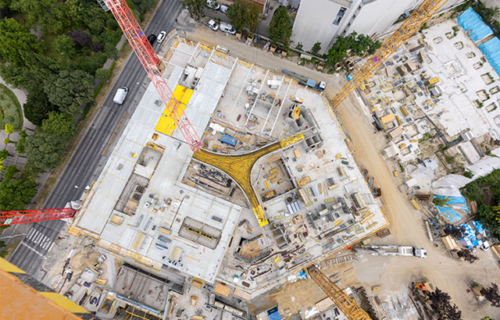Timber is increasingly being recognized as a renewable and deconstructable building material with immense potential in structural engineering, though its full capabilities remain largely untapped. However, large-scale projects like Vienna’s LeopoldQuartier are providing valuable insights and demonstrating what timber can achieve in modern construction.
Austria is witnessing a surge in timber construction, with about 25% of the floor space in high-rise buildings now incorporating wood, particularly in the residential sector, which accounts for 53% of these projects. “Sustainable urban living spaces can be efficiently developed using timber, a material that aligns with the principles of the circular economy,” said PORR CEO Karl-Heinz Strauss. “Every year, 30 million cubic meters of wood regrow in Austria, with 90% of it used and recycled. This equates to the creation of 2,000 single-family homes daily, contributing to a ‘second forest’ of houses that also sequesters carbon dioxide.” However, the rarity of large-scale timber projects has limited comprehensive experience, product approvals, and certifications.
Leading this movement is LeopoldQuartier, Europe’s first timber-framed urban district, under development by UBM on Vienna’s Donaukanal. Covering nearly three hectares, the project aims to set a benchmark for sustainable construction. “Choosing LeopoldQuartier means actively contributing to the fight against climate change,” said Peter Schaller, CEO of UBM Development AG.
The centerpiece of the project is a 22,000 sqm office building featuring a timber hybrid construction. The load-bearing structure, composed of laminated timber columns, cross-laminated timber walls, and timber-concrete composite ceilings, will rise from the first to the ninth floor. Approximately 2,800 cubic meters of timber will be used, with CO2 savings estimated at 2,700 tons compared to conventional reinforced concrete construction. The office building is slated for completion by October 2025.
LeopoldQuartier’s residential component, known as LeopoldQuartier Living, includes 253 apartments, making it Austria’s largest timber-based residential project. It will utilize 3,800 cubic meters of prefabricated timber elements, including 20,000 sqm of cross-laminated timber ceilings and walls, and 7,000 sqm of timber frame exterior walls. The rapid assembly of 204 prefabricated bathroom units is expected to accelerate the construction timeline, with completion anticipated in early 2026.
Sustainability extends beyond construction materials in LeopoldQuartier. The project will be powered by 200 geothermal probes and three wells, complemented by photovoltaics and heating/cooling panels. The office building is targeting DGNB Gold certification, a mark of sustainable building practices.
UBM is positioning itself as Europe’s leading developer of timber hybrid buildings, with an ambitious EUR 1.9 billion project pipeline. Over 90% of its developments are located in Germany and Austria, with 59% dedicated to residential spaces and 41% to light industrial and office buildings. Notable projects include Timber Factory in Munich, and Timber Peak and Timber View in Mainz.
PORR, a pioneer in timber and timber hybrid construction, is at the forefront of eight major projects across Austria, including LeopoldQuartier, the “Vis à Vis” in Vienna and Graz, and the European Patent Office in Munich. These projects provide a testing ground for the evolving standards and certifications required for large-scale timber construction.
LeopoldQuartier offers PORR a rare opportunity to execute an office and residential project on an unprecedented scale in Austria. “Flagship projects like this push the boundaries of current construction standards and help refine serial timber construction methods, unlocking the full potential of timber for large-scale developments,” Strauss emphasized.
With each successful timber project, the industry moves closer to realizing timber’s vast potential as a sustainable building material for the future.
